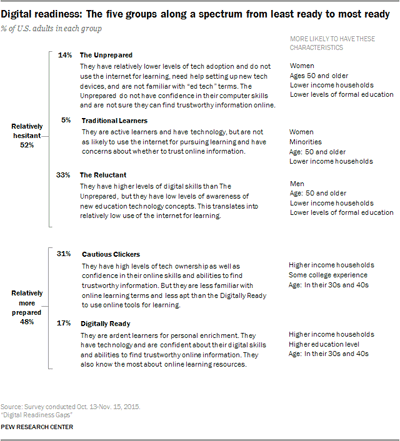Digital Readiness Gaps [REPORT]
September 21, 2016
![]() By John B. Horrigan
By John B. Horrigan

For many years concerns about “digital divides” centered primarily on whether people had access to digital technologies. Now, those worried about these issues also focus on the degree to which people succeed or struggle when they use technology to try to navigate their environments, solve problems, and make decisions. A recent Pew Research Center report showed that adoption of technology for adult learning in both personal and job-related activities varies by people’s socio-economic status, their race and ethnicity, and their level of access to home broadband and smartphones. Another report showed that some users are unable to make the internet and mobile devices function adequately for key activities such as looking for jobs.
In this report, we use newly released Pew Research Center survey findings to address a related issue: digital readiness. The new analysis explores the attitudes and behaviors that underpin people’s preparedness and comfort in using digital tools for learning as we measured it in a survey about people’s activities for personal learning.
Specifically, we assess American adults according to five main factors: their confidence in using computers, their facility with getting new technology to work, their use of digital tools for learning, their ability to determine the trustworthiness of online information, and their familiarity with contemporary “education tech” terms. It is important to note that the findings here just cover people’s learning activities in digital spaces and do not address the full range of important things that people can do online or their “readiness” to perform them.
To better understand the way in which different groups of Americans line up when it comes to digital readiness, researchers used a statistical technique called cluster analysis that places people into groups based on similarities in their answers to key questions.
The analysis shows there are several distinct groups of Americans who fall along a spectrum of digital readiness from relatively more prepared to relatively hesitant. Those who tend to be hesitant about embracing technology in learning are below average on the measures of readiness, such as needing help with new electronic gadgets or having difficulty determining whether online information is trustworthy. Those whose profiles indicate a higher level of preparedness for using tech in learning are collectively above average on measures of digital readiness.
To download report CLICK HERE.




























